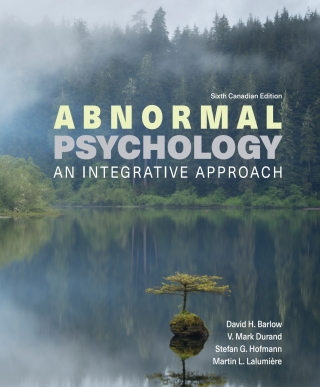Buy ABNORMAL PSYCHOLOGY 6CE, 6th Edition PDF ebook by author Barlow, Hofmann – published by Cengage Learning Canada Inc. in 2021 and save up to 80% compared to the print version of this textbook. With PDF version of this textbook, not only save you money, you can also highlight, add text, underline add post-it notes, bookmarks to pages, instantly search for the major terms or chapter titles, etc.
You can search our site for other versions of the ABNORMAL PSYCHOLOGY 6CE, 6th Edition PDF ebook. You can also search for others PDF ebooks from publisher Cengage Learning Canada Inc., as well as from your favorite authors. We have thousands of online textbooks and course materials (mostly in PDF) that you can download immediately after purchase.
Note: e-textBooks do not come with access codes, CDs/DVDs, workbooks, and other supplemental items.
eBook Details:
Full title: ABNORMAL PSYCHOLOGY 6CE, 6th Edition
Edition: 6th
Copyright year: 2021
Publisher: Cengage Learning Canada Inc.
Author: Barlow, Hofmann
ISBN: 9780176873219, 9780176874827
Format: PDF
Description of ABNORMAL PSYCHOLOGY 6CE, 6th Edition:
The sixth Canadian edition of Abnormal Psychology continues its groundbreaking integrative approach to delivering the most modern, scientifically valid method for studying abnormal psychology through its balance of biological, psychological, social, and cultural factors. The author team blends sophisticated research and an accessible writing style with the most widely recognized method of discussing psychopathology. Going beyond simply describing different schools of thought on psychological disorders, the authors explore the interactions of the various forces that contribute to psychopathology. Revised to be lighter and easier to comprehend, the conversational writing style and consistent pedagogical elements of this textas well as integrated case studies (95 percent from the authors’ own files) and additional study toolsmake this the most comprehensive resource on Abnormal Psychology available.
Table of Contents of ABNORMAL PSYCHOLOGY 6CE, 6th Edition PDF ebook:
Front EndsheetAbnormal PsychologyAbout the AuthorsBrief ContentsContentsPrefaceChapter 1 Abnormal Behaviour in Historical ContextWhat Is a Psychological Disorder?Psychological DysfunctionAtypical or Not Culturally ExpectedPersonal Distress or ImpairmentAn Accepted Definition?The Science of PsychopathologyThe Scientist-PractitionerClinical DescriptionCausation, Treatment, and OutcomesThe Supernatural TraditionDemons and WitchesStress and MelancholyTreatments for PossessionThe Moon and the StarsCommentsThe Biological TraditionHippocrates and GalenThe 19th CenturyThe Development of Biological TreatmentsConsequences of the Biological TraditionThe Psychological TraditionMoral TherapyAsylum Reform and the Decline of Moral TherapyPsychoanalytic TheoryHumanistic TheoryThe Behavioural ModelThe Scientific Method and an Integrative ApproachSummaryKey TermsAnswers to Concept ChecksMedia ResourcesChapter 2 An Integrative Approach to PsychopathologyOne-Dimensional or MultidimensionalÊModelsWhat Caused JodyÕs Phobia?Outcome and CommentsGenetic Contributions to PsychopathologyThe Nature of GenesNew Developments in the Study of GenesÊand BehaviourThe Interaction of Genetic and Environmental EffectsEpigenetics and the Nongenomic ÒInheritanceÓ of BehaviourNeuroscience and Its Contributions to PsychopathologyThe Central Nervous SystemThe Structure of the BrainThe Peripheral Nervous SystemNeurotransmittersImplications for PsychopathologyPsychosocial Influences on Brain Structure and FunctionInteractions of Psychosocial Factors with Brain Structure and FunctionCommentsBehavioural and Cognitive ScienceConditioning and Cognitive ProcessesLearned HelplessnessSocial LearningPrepared LearningCognitive Science and the UnconsciousCognitive-Behavioural TherapyEmotionsThe Physiology and Purpose of FearEmotional PhenomenaThe Components of EmotionEmotions and PsychopathologyCultural, Social, and Interpersonal FactorsGender RolesSocial Effects on Health and BehaviourLifespan DevelopmentThe Principle of EquifinalityConclusionsSummaryKey TermsAnswers to Concept ChecksMedia ResourcesChapter 3 Clinical Assessment and DiagnosisAssessing Psychological DisordersThe Clinical InterviewPhysical ExaminationBehavioural AssessmentPsychological TestingNeuropsychological TestingNeuroimaging: Pictures of the BrainPsychophysiological AssessmentDiagnosing Psychological DisordersClassification IssuesDiagnosis before 1980DSM-III and DSM-III-RDSM-IV and DSM-IV-TRDSM-5Creating a DiagnosisBeyond DSM-5: Dimensions and SpectraSummaryKey TermsAnswers to Concept ChecksMedia ResourcesChapter 4 Research MethodsImportant ConceptsBasic Components of a Research StudyStatistical versus Clinical SignificanceThe Average ClientStudying Individual CasesResearch by CorrelationEpidemiological ResearchResearch by ExperimentExperimental DesignsProcess and Outcome of TreatmentSingle-Case Experimental DesignsRepeated MeasurementsWithdrawal DesignsMultiple BaselinesStudying GeneticsFamily StudiesAdoption StudiesTwin StudiesGenetic Linkage Analysis and Association StudiesStudying Behaviour over TimePrevention ResearchCross-Sectional DesignsLongitudinal DesignsStudying Behaviour across CulturesThe Power of a Program of ResearchReplicationResearch EthicsSummaryKey TermsAnswers to Concept ChecksMedia ResourcesChapter 5 AnxietyThe Complexity of Anxiety DisordersAnxiety, Fear, and PanicCauses of AnxietyComorbidityComorbidity with Physical DisordersSuicideGeneralized Anxiety DisorderClinical DescriptionStatisticsCausesTreatmentPanic Disorder and AgoraphobiaClinical DescriptionStatisticsCausesTreatmentSpecific PhobiaClinical DescriptionStatisticsCausesTreatmentSocial Anxiety Disorder (Social Phobia)Clinical DescriptionStatisticsCausesTreatmentSummaryKey TermsAnswers to Concept ChecksMedia ResourcesChapter 6 Preoccupation and ObsessionSomatic Symptom Disorder andÊRelated DisordersSomatic Symptom DisorderIllness Anxiety DisorderPsychological Factors Affecting Medical ConditionConversion Disorder (Functional Neurological Symptom Disorder)Obsessive-Compulsive and Related DisordersObsessive-Compulsive DisorderBody Dysmorphic DisorderHoarding DisorderTrichotillomania and Excoriation DisorderSummaryKey TermsAnswers to Concept ChecksMedia ResourcesChapter 7 Trauma and DissociationTrauma- and Stressor-Related DisordersPost-Traumatic Stress DisorderOther Trauma- and Stressor-Related DisordersDissociative DisordersDepersonalization-Derealization DisorderDissociative AmnesiaDissociative Identity DisorderSummaryKey TermsAnswers to Concept ChecksMedia ResourcesChapter 8 MoodAn Overview of Depression and ManiaThe Structure of Mood DisordersDepressive DisordersClinical DescriptionOnset and DurationFrom Grief to DepressionOther Depressive DisordersBipolar DisordersClinical DescriptionOnset and DurationPrevalence of Mood DisordersLifespan Developmental Influences on Mood DisordersIn Children and AdolescentsIn Older AdultsAcross CulturesAmong the CreativeCauses of Mood DisordersBiological DimensionsAdditional Studies of Brain Structure and FunctionPsychological DimensionsSocial and Cultural DimensionsAn Integrative TheoryTreatmentMedicationsElectroconvulsive Therapy and Transcranial Magnetic StimulationPsychosocial TreatmentsCombined TreatmentsPreventing RelapsePsychosocial Treatments for Bipolar DisorderSuicideStatisticsCausesRisk FactorsIs Suicide Contagious?TreatmentSummaryKey TermsAnswers to Concept ChecksMedia ResourcesChapter 9 EatingOverview of Eating DisordersBulimia NervosaAnorexia NervosaBinge-Eating DisorderStatisticsCauses of Eating DisordersSocial DimensionsBiological DimensionsPsychological DimensionsAn Integrative ModelTreatment of Eating DisordersDrug TreatmentsPsychosocial TreatmentsPreventing Eating DisordersSummaryKey TermsAnswers to Concept ChecksMedia ResourcesChapter 10 SleepingAn Overview of Sleep-Wake DisordersInsomnia DisorderHypersomnolence DisordersNarcolepsyBreathing-Related Sleep DisordersCircadian Rhythm Sleep-Wake DisordersTreatment of Sleep-Wake DisordersMedical TreatmentsEnvironmental TreatmentsPsychological TreatmentsPreventing Sleep DisordersParasomnias and Their TreatmentSummaryKey TermsAnswers to Concept ChecksMedia ResourcesChapter 11 Sex and GenderAn Overview of Sexual DysfunctionsSexual Desire DisordersSexual Arousal DisordersOrgasm DisordersSexual Pain DisordersAssessing Sexual BehaviourInterviewsMedical ExaminationPsychophysiological AssessmentCauses of Sexual DysfunctionBiological ContributionsPsychological ContributionsSocial and Cultural ContributionsThe Interaction of Psychological and Physical FactorsTreatment of Sexual DysfunctionPsychosocial TreatmentsMedical TreatmentsSummaryAn Overview of Paraphilic DisordersFetishistic DisorderVoyeuristic and Exhibitionistic DisordersTransvestic DisorderSexual Sadism and Sexual Masochism DisordersPedophilic DisorderParaphilic Disorders in WomenCauses of Paraphilic DisordersAssessing and Treating Paraphilic DisordersAssessmentPsychosocial TreatmentDrug TreatmentsAn Overview of Gender DysphoriaCausesTreatmentSummaryKey TermsAnswers to Concept ChecksMedia ResourcesChapter 12 Substance Use and Impulse ControlDepressantsAlcohol-Related DisordersSedative-, Hypnotic-, and Anxiolytic-Related DisordersStimulantsStimulant-Related DisordersTobacco-Related DisordersCaffeine-Related DisordersOpioidsHallucinogensCannabisOther DrugsCausesBiological DimensionsPsychological DimensionsSocial DimensionsCultural DimensionsAn Integrative ModelTreatmentBiological TreatmentsPsychosocial TreatmentsHarm ReductionPreventionGambling DisorderImpulse-Control DisordersIntermittent Explosive DisorderKleptomaniaPyromaniaSummaryKey TermsAnswers to Concept ChecksMedia ResourcesChapter 13 PersonalityAn OverviewCategorical and Dimensional ModelsPersonality Disorder ClustersStatistics and DevelopmentGender DifferencesComorbidityCluster A DisordersParanoid Personality DisorderSchizoid Personality DisorderSchizotypal Personality DisorderCluster B DisordersAntisocial Personality DisorderBorderline Personality DisorderHistrionic Personality DisorderNarcissistic Personality DisorderCluster C DisordersAvoidant Personality DisorderDependent Personality DisorderObsessive-Compulsive Personality DisorderPersonality Disorders under StudySummaryKey TermsAnswers to Concept ChecksMedia ResourcesChapter 14 PsychosisPerspectives on the Concept ofÊSchizophreniaEarly Figures in Diagnosing SchizophreniaIdentifying SymptomsClinical DescriptionPositive SymptomsNegative SymptomsDisorganized SymptomsOther Psychotic DisordersPrevalence and Causes of SchizophreniaStatisticsDevelopmentCultural FactorsGenetic InfluencesNeurobiological InfluencesPsychological and Social InfluencesTreatmentBiological InterventionsPsychosocial InterventionsTreatment across CulturesPreventionSummaryKey TermsAnswers to Concept ChecksMedia ResourcesChapter 15 NeurodevelopmentPerspectivesAttention-Deficit/HyperactivityÊDisorderClinical DescriptionStatisticsCausesTreatmentSpecific Learning DisorderClinical DescriptionStatisticsCausesTreatmentAutism Spectrum DisorderClinical DescriptionStatisticsCauses: Biological DimensionsCauses: Psychological and Social DimensionsTreatmentPrevention of Neurodevelopmental DisordersSummaryKey TermsAnswers to Concept ChecksMedia ResourcesChapter 16 Aging and NeurocognitionPerspectivesDeliriumClinical Description and StatisticsTreatmentPreventionMajor and Mild Neurocognitive DisordersClinical Description and StatisticsNeurocognitive Disorder of the AlzheimerÕs TypeVascular Neurocognitive DisorderOther Medical Conditions That Cause Neurocognitive DisorderSubstance/Medication-Induced Neurocognitive DisorderCausesTreatmentPreventionSummaryKey TermsAnswers to Concept ChecksMedia ResourcesChapter 17 Mental Health and the LawCivil CommitmentCriteria for Civil CommitmentDefining Mental IllnessDangerousnessDeinstitutionalization and HomelessnessCriminal CommitmentThe Insanity DefenceReactions to the Insanity DefenceFitness to Stand TrialDuty to Warn and ProtectMental Health Professionals as Expert WitnessesEthics and Treatment of Mental IllnessBoundary IssuesDo No HarmRecognizing Limits of CompetencePatientsÕ RightsThe Right to TreatmentThe Right to Refuse TreatmentThe Rights of Research ParticipantsClinical Practice GuidelinesConclusionsSummaryKey TermsAnswers to Concept ChecksMedia ResourcesGlossaryReferencesName IndexSubject IndexBack EndsheetBlank Page





